Mustansar Fiaz
HyRet-Change: A hybrid retentive network for remote sensing change detection
Jun 15, 2025Abstract:Recently convolution and transformer-based change detection (CD) methods provide promising performance. However, it remains unclear how the local and global dependencies interact to effectively alleviate the pseudo changes. Moreover, directly utilizing standard self-attention presents intrinsic limitations including governing global feature representations limit to capture subtle changes, quadratic complexity, and restricted training parallelism. To address these limitations, we propose a Siamese-based framework, called HyRet-Change, which can seamlessly integrate the merits of convolution and retention mechanisms at multi-scale features to preserve critical information and enhance adaptability in complex scenes. Specifically, we introduce a novel feature difference module to exploit both convolutions and multi-head retention mechanisms in a parallel manner to capture complementary information. Furthermore, we propose an adaptive local-global interactive context awareness mechanism that enables mutual learning and enhances discrimination capability through information exchange. We perform experiments on three challenging CD datasets and achieve state-of-the-art performance compared to existing methods. Our source code is publicly available at https://github.com/mustansarfiaz/HyRect-Change.
* Accepted at IEEE IGARSS 2025
InceptionMamba: Efficient Multi-Stage Feature Enhancement with Selective State Space Model for Microscopic Medical Image Segmentation
Jun 13, 2025Abstract:Accurate microscopic medical image segmentation plays a crucial role in diagnosing various cancerous cells and identifying tumors. Driven by advancements in deep learning, convolutional neural networks (CNNs) and transformer-based models have been extensively studied to enhance receptive fields and improve medical image segmentation task. However, they often struggle to capture complex cellular and tissue structures in challenging scenarios such as background clutter and object overlap. Moreover, their reliance on the availability of large datasets for improved performance, along with the high computational cost, limit their practicality. To address these issues, we propose an efficient framework for the segmentation task, named InceptionMamba, which encodes multi-stage rich features and offers both performance and computational efficiency. Specifically, we exploit semantic cues to capture both low-frequency and high-frequency regions to enrich the multi-stage features to handle the blurred region boundaries (e.g., cell boundaries). These enriched features are input to a hybrid model that combines an Inception depth-wise convolution with a Mamba block, to maintain high efficiency and capture inherent variations in the scales and shapes of the regions of interest. These enriched features along with low-resolution features are fused to get the final segmentation mask. Our model achieves state-of-the-art performance on two challenging microscopic segmentation datasets (SegPC21 and GlaS) and two skin lesion segmentation datasets (ISIC2017 and ISIC2018), while reducing computational cost by about 5 times compared to the previous best performing method.
Open-Set Semi-Supervised Learning for Long-Tailed Medical Datasets
May 20, 2025Abstract:Many practical medical imaging scenarios include categories that are under-represented but still crucial. The relevance of image recognition models to real-world applications lies in their ability to generalize to these rare classes as well as unseen classes. Real-world generalization requires taking into account the various complexities that can be encountered in the real-world. First, training data is highly imbalanced, which may lead to model exhibiting bias toward the more frequently represented classes. Moreover, real-world data may contain unseen classes that need to be identified, and model performance is affected by the data scarcity. While medical image recognition has been extensively addressed in the literature, current methods do not take into account all the intricacies in the real-world scenarios. To this end, we propose an open-set learning method for highly imbalanced medical datasets using a semi-supervised approach. Understanding the adverse impact of long-tail distribution at the inherent model characteristics, we implement a regularization strategy at the feature level complemented by a classifier normalization technique. We conduct extensive experiments on the publicly available datasets, ISIC2018, ISIC2019, and TissueMNIST with various numbers of labelled samples. Our analysis shows that addressing the impact of long-tail data in classification significantly improves the overall performance of the network in terms of closed-set and open-set accuracies on all datasets. Our code and trained models will be made publicly available at https://github.com/Daniyanaj/OpenLTR.
EarthDial: Turning Multi-sensory Earth Observations to Interactive Dialogues
Dec 19, 2024



Abstract:Automated analysis of vast Earth observation data via interactive Vision-Language Models (VLMs) can unlock new opportunities for environmental monitoring, disaster response, and resource management. Existing generic VLMs do not perform well on Remote Sensing data, while the recent Geo-spatial VLMs remain restricted to a fixed resolution and few sensor modalities. In this paper, we introduce EarthDial, a conversational assistant specifically designed for Earth Observation (EO) data, transforming complex, multi-sensory Earth observations into interactive, natural language dialogues. EarthDial supports multi-spectral, multi-temporal, and multi-resolution imagery, enabling a wide range of remote sensing tasks, including classification, detection, captioning, question answering, visual reasoning, and visual grounding. To achieve this, we introduce an extensive instruction tuning dataset comprising over 11.11M instruction pairs covering RGB, Synthetic Aperture Radar (SAR), and multispectral modalities such as Near-Infrared (NIR) and infrared. Furthermore, EarthDial handles bi-temporal and multi-temporal sequence analysis for applications like change detection. Our extensive experimental results on 37 downstream applications demonstrate that EarthDial outperforms existing generic and domain-specific models, achieving better generalization across various EO tasks.
CLIP meets DINO for Tuning Zero-Shot Classifier using Unlabeled Image Collections
Nov 28, 2024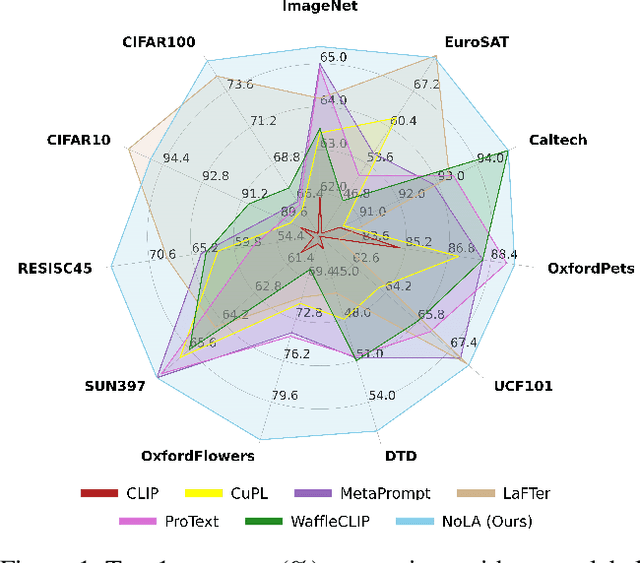
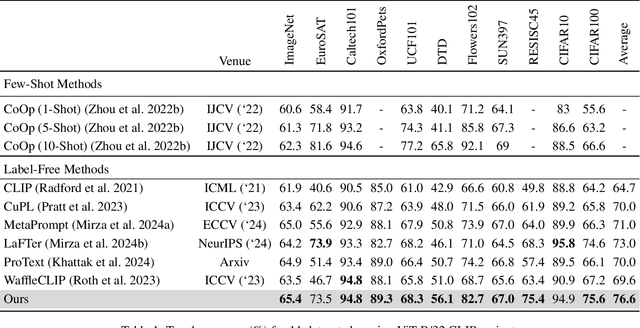
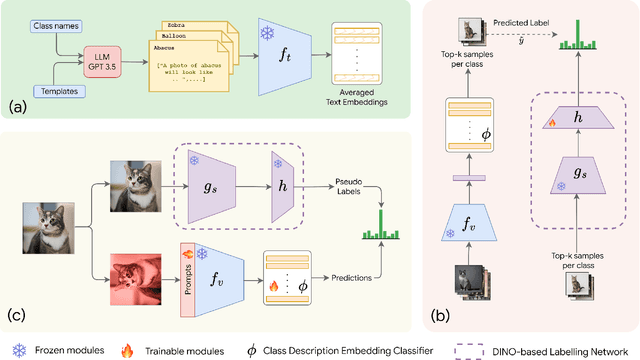

Abstract:In the era of foundation models, CLIP has emerged as a powerful tool for aligning text and visual modalities into a common embedding space. However, the alignment objective used to train CLIP often results in subpar visual features for fine-grained tasks. In contrast, SSL-pretrained models like DINO excel at extracting rich visual features due to their specialized training paradigm. Yet, these SSL models require an additional supervised linear probing step, which relies on fully labeled data which is often expensive and difficult to obtain at scale. In this paper, we propose a label-free prompt-tuning method that leverages the rich visual features of self-supervised learning models (DINO) and the broad textual knowledge of large language models (LLMs) to largely enhance CLIP-based image classification performance using unlabeled images. Our approach unfolds in three key steps: (1) We generate robust textual feature embeddings that more accurately represent object classes by leveraging class-specific descriptions from LLMs, enabling more effective zero-shot classification compared to CLIP's default name-specific prompts. (2) These textual embeddings are then used to produce pseudo-labels to train an alignment module that integrates the complementary strengths of LLM description-based textual embeddings and DINO's visual features. (3) Finally, we prompt-tune CLIP's vision encoder through DINO-assisted supervision using the trained alignment module. This three-step process allows us to harness the best of visual and textual foundation models, resulting in a powerful and efficient approach that surpasses state-of-the-art label-free classification methods. Notably, our framework, NoLA (No Labels Attached), achieves an average absolute gain of 3.6% over the state-of-the-art LaFter across 11 diverse image classification datasets.
COSNet: A Novel Semantic Segmentation Network using Enhanced Boundaries in Cluttered Scenes
Oct 31, 2024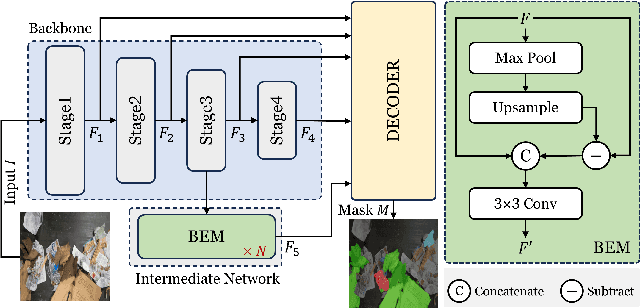

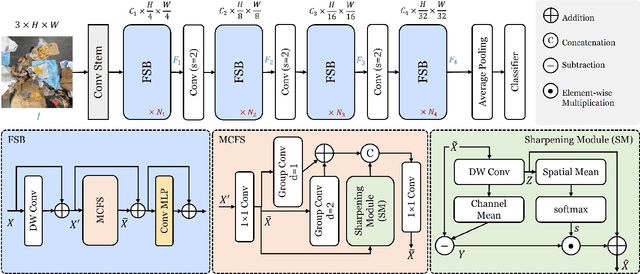

Abstract:Automated waste recycling aims to efficiently separate the recyclable objects from the waste by employing vision-based systems. However, the presence of varying shaped objects having different material types makes it a challenging problem, especially in cluttered environments. Existing segmentation methods perform reasonably on many semantic segmentation datasets by employing multi-contextual representations, however, their performance is degraded when utilized for waste object segmentation in cluttered scenarios. In addition, plastic objects further increase the complexity of the problem due to their translucent nature. To address these limitations, we introduce an efficacious segmentation network, named COSNet, that uses boundary cues along with multi-contextual information to accurately segment the objects in cluttered scenes. COSNet introduces novel components including feature sharpening block (FSB) and boundary enhancement module (BEM) for enhancing the features and highlighting the boundary information of irregular waste objects in cluttered environment. Extensive experiments on three challenging datasets including ZeroWaste-f, SpectralWaste, and ADE20K demonstrate the effectiveness of the proposed method. Our COSNet achieves a significant gain of 1.8% on ZeroWaste-f and 2.1% on SpectralWaste datasets respectively in terms of mIoU metric.
Improving 3D Medical Image Segmentation at Boundary Regions using Local Self-attention and Global Volume Mixing
Oct 20, 2024



Abstract:Volumetric medical image segmentation is a fundamental problem in medical image analysis where the objective is to accurately classify a given 3D volumetric medical image with voxel-level precision. In this work, we propose a novel hierarchical encoder-decoder-based framework that strives to explicitly capture the local and global dependencies for volumetric 3D medical image segmentation. The proposed framework exploits local volume-based self-attention to encode the local dependencies at high resolution and introduces a novel volumetric MLP-mixer to capture the global dependencies at low-resolution feature representations, respectively. The proposed volumetric MLP-mixer learns better associations among volumetric feature representations. These explicit local and global feature representations contribute to better learning of the shape-boundary characteristics of the organs. Extensive experiments on three different datasets reveal that the proposed method achieves favorable performance compared to state-of-the-art approaches. On the challenging Synapse Multi-organ dataset, the proposed method achieves an absolute 3.82\% gain over the state-of-the-art approaches in terms of HD95 evaluation metrics {while a similar improvement pattern is exhibited in MSD Liver and Pancreas tumor datasets}. We also provide a detailed comparison between recent architectural design choices in the 2D computer vision literature by adapting them for the problem of 3D medical image segmentation. Finally, our experiments on the ZebraFish 3D cell membrane dataset having limited training data demonstrate the superior transfer learning capabilities of the proposed vMixer model on the challenging 3D cell instance segmentation task, where accurate boundary prediction plays a vital role in distinguishing individual cell instances.
A Survey of the Self Supervised Learning Mechanisms for Vision Transformers
Aug 30, 2024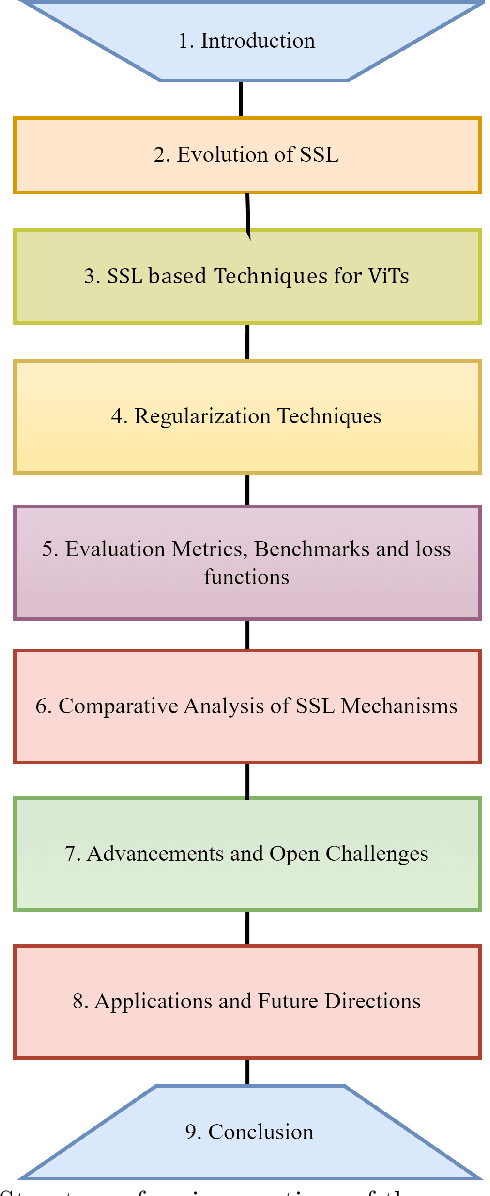
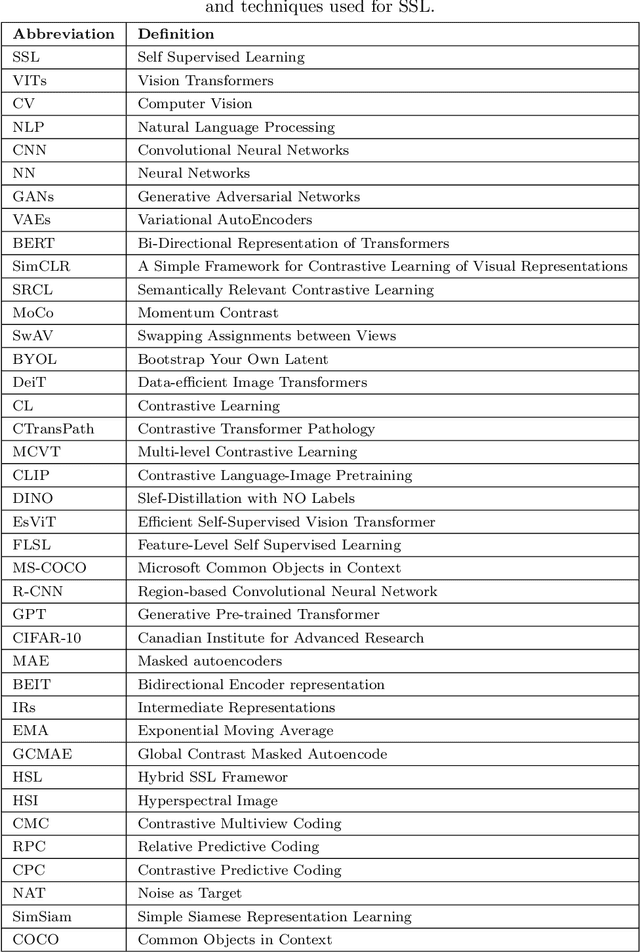
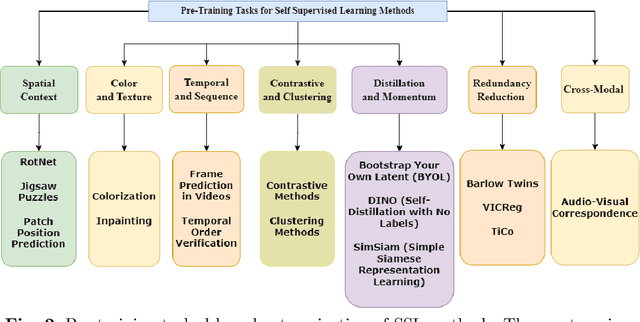
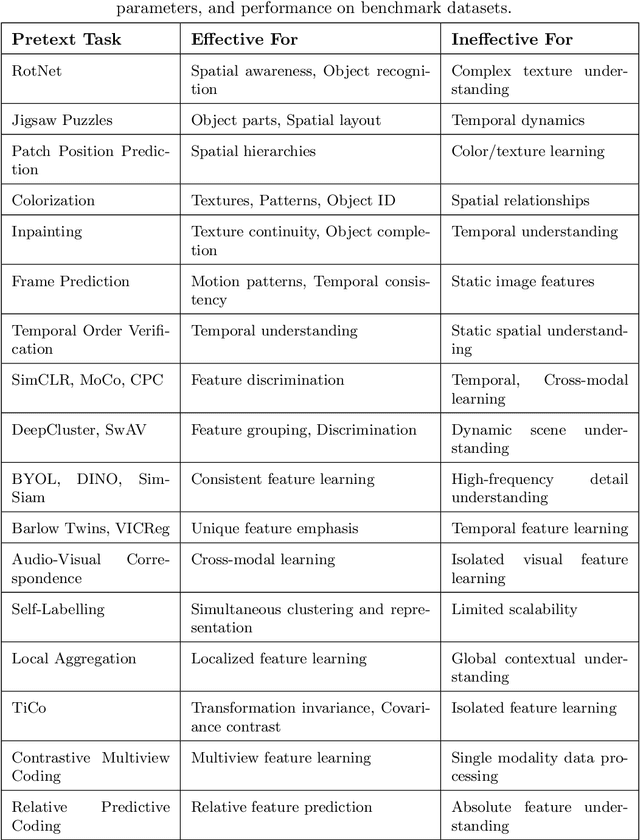
Abstract:Deep supervised learning models require high volume of labeled data to attain sufficiently good results. Although, the practice of gathering and annotating such big data is costly and laborious. Recently, the application of self supervised learning (SSL) in vision tasks has gained significant attention. The intuition behind SSL is to exploit the synchronous relationships within the data as a form of self-supervision, which can be versatile. In the current big data era, most of the data is unlabeled, and the success of SSL thus relies in finding ways to improve this vast amount of unlabeled data available. Thus its better for deep learning algorithms to reduce reliance on human supervision and instead focus on self-supervision based on the inherent relationships within the data. With the advent of ViTs, which have achieved remarkable results in computer vision, it is crucial to explore and understand the various SSL mechanisms employed for training these models specifically in scenarios where there is less label data available. In this survey we thus develop a comprehensive taxonomy of systematically classifying the SSL techniques based upon their representations and pre-training tasks being applied. Additionally, we discuss the motivations behind SSL, review popular pre-training tasks, and highlight the challenges and advancements in this field. Furthermore, we present a comparative analysis of different SSL methods, evaluate their strengths and limitations, and identify potential avenues for future research.
FANet: Feature Amplification Network for Semantic Segmentation in Cluttered Background
Jul 12, 2024Abstract:Existing deep learning approaches leave out the semantic cues that are crucial in semantic segmentation present in complex scenarios including cluttered backgrounds and translucent objects, etc. To handle these challenges, we propose a feature amplification network (FANet) as a backbone network that incorporates semantic information using a novel feature enhancement module at multi-stages. To achieve this, we propose an adaptive feature enhancement (AFE) block that benefits from both a spatial context module (SCM) and a feature refinement module (FRM) in a parallel fashion. SCM aims to exploit larger kernel leverages for the increased receptive field to handle scale variations in the scene. Whereas our novel FRM is responsible for generating semantic cues that can capture both low-frequency and high-frequency regions for better segmentation tasks. We perform experiments over challenging real-world ZeroWaste-f dataset which contains background-cluttered and translucent objects. Our experimental results demonstrate the state-of-the-art performance compared to existing methods.
Medical Image Segmentation Using Directional Window Attention
Jun 25, 2024



Abstract:Accurate segmentation of medical images is crucial for diagnostic purposes, including cell segmentation, tumor identification, and organ localization. Traditional convolutional neural network (CNN)-based approaches struggled to achieve precise segmentation results due to their limited receptive fields, particularly in cases involving multi-organ segmentation with varying shapes and sizes. The transformer-based approaches address this limitation by leveraging the global receptive field, but they often face challenges in capturing local information required for pixel-precise segmentation. In this work, we introduce DwinFormer, a hierarchical encoder-decoder architecture for medical image segmentation comprising a directional window (Dwin) attention and global self-attention (GSA) for feature encoding. The focus of our design is the introduction of Dwin block within DwinFormer that effectively captures local and global information along the horizontal, vertical, and depthwise directions of the input feature map by separately performing attention in each of these directional volumes. To this end, our Dwin block introduces a nested Dwin attention (NDA) that progressively increases the receptive field in horizontal, vertical, and depthwise directions and a convolutional Dwin attention (CDA) that captures local contextual information for the attention computation. While the proposed Dwin block captures local and global dependencies at the first two high-resolution stages of DwinFormer, the GSA block encodes global dependencies at the last two lower-resolution stages. Experiments over the challenging 3D Synapse Multi-organ dataset and Cell HMS dataset demonstrate the benefits of our DwinFormer over the state-of-the-art approaches. Our source code will be publicly available at \url{https://github.com/Daniyanaj/DWINFORMER}.
 Add to Chrome
Add to Chrome Add to Firefox
Add to Firefox Add to Edge
Add to Edge